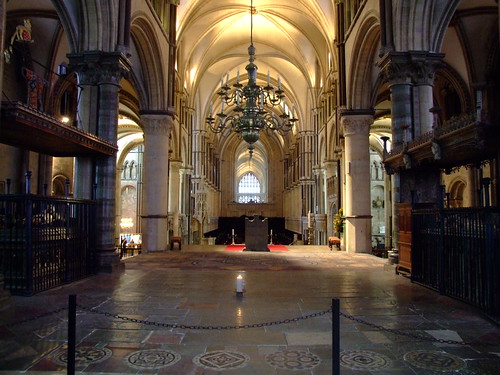Putting Becket's name out of all the bokes
Father Daren J. Zehnle, KHS, a priest of the Diocese of Springfield in Illinois, studying Canon Law at the Greg, was pleased to have just had approval to submit his thesis on the order and age of Confirmation in the Latin Church with only minor amendments (Congratulations, Father!), and so found himself with some extra time after visiting Scotland recently. He travelled South to make a pilgrimage to the grave of JRR Tolkien. He also made a last-minute decision to visit Canterbury and the site of the shrine of St Thomas.
You can read his post The hooly blisful martir for to seke and enjoy some great photographs. Here is my own photo of the place of the shrine:
It was reckoned to be one of the most richly adorned shrines in Christendom, thanks to the generosity and devotion of the pilgrims who donated to it. I find it heartbreaking to look over the empty space resulting from the callous and spiteful destruction of Henry VIII which also involved the alienation of a large amount of valuable property. Apparently 26 wagons were needed to carry off the valuables after the attentions of the Commission for the Destruction of Shrines. What could be melted down ended up at the Royal Mint at the Tower of London.
St Thomas excited Henry's particular hatred because he stood up for the rights of the Church against the usurpations of the crown. The story of St Thomas being put on trial for treason and being sentenced to having his bones burnt seems to be reckoned as apocryphal, but there was a determined effort at rubbishing his memory by blaming his death on his own behavour.
In a damnatio memoriae, his images were ordered to be destroyed and his name to be erased:
You can read his post The hooly blisful martir for to seke and enjoy some great photographs. Here is my own photo of the place of the shrine:
It was reckoned to be one of the most richly adorned shrines in Christendom, thanks to the generosity and devotion of the pilgrims who donated to it. I find it heartbreaking to look over the empty space resulting from the callous and spiteful destruction of Henry VIII which also involved the alienation of a large amount of valuable property. Apparently 26 wagons were needed to carry off the valuables after the attentions of the Commission for the Destruction of Shrines. What could be melted down ended up at the Royal Mint at the Tower of London.
St Thomas excited Henry's particular hatred because he stood up for the rights of the Church against the usurpations of the crown. The story of St Thomas being put on trial for treason and being sentenced to having his bones burnt seems to be reckoned as apocryphal, but there was a determined effort at rubbishing his memory by blaming his death on his own behavour.
"And he not only callyd the one of them bawde, but also toke Tracy by the bosome, and violently shoke and plucked hym in suche maner, that he had almoste overthrowen hym to the pavement of the Churche; so that upon this fray one of their company, perceivynge the same, strake hym, and so in the thronge Becket was slayne."(Quoted in: Constitutions of Clarendon "Henry VIII's Proclamation, 1538: The Unsainting of Thomas Becket")I suppose with all that taking by the bosome, shaking and plucking, and calling people bawdy he was just asking to have his skull cleaved in half and his brains poured out all over the flagstones.
In a damnatio memoriae, his images were ordered to be destroyed and his name to be erased:
"Therefore his Grace strayghtly chargeth and commandeth that from henseforth the sayde Thomas Becket shall not be estemed, named, reputed, nor called a sayncte, but bysshop Becket; and that his ymages and pictures, through the hole realme, shall be putte downe, and avoyded out of all churches, chapelles, and other places; and that from henseforthe, the dayes used to be festivall in his name shall not be observed, nor the service, office, antiphoners, colletes, and prayers, in his name redde, but rased and put out of all the bokes.”Some of those "bokes" can be found in the British Library whose Medieval Manuscripts blog has a fascinating page on Erasing Becket.


